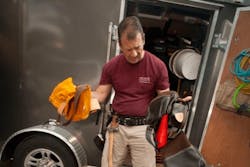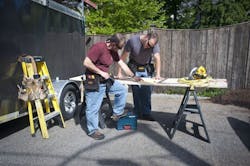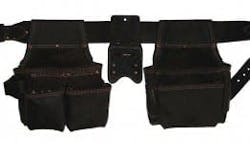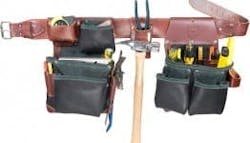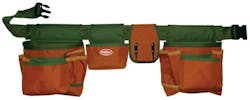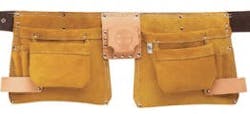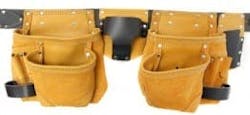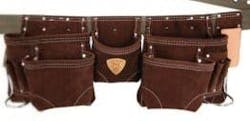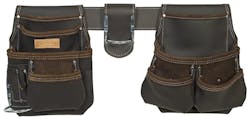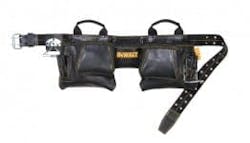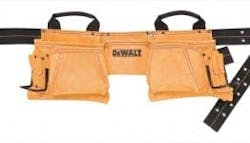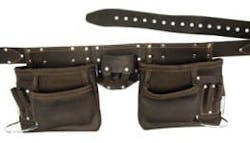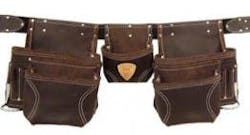Which Nail Bags Are Best 4 U?
This review started off as a sort of bait and switch. You see, I was asked if I would like to review “a tool belt or two” for the magazine.
What should have occurred was the sound of a robotic voice, saying “Danger, Will Robinson!”
Alas, I’m a bit naive. “Sure, send them over,” I said. Choosing the best tool belt isn’t hard if you’re choosing from a couple available selections.
Of course, a week or two later I arrived home to a massive onslaught of boxes on my doorstep. A “tool belt or two” somehow evolved into a dozen tool belts with the promise of more to come. Finding the best tool belt just got a lot more time intensive.
If you read my articles, you know that I try to bring all of the tools and products I review to the toughest, meanest and dirtiest testing facility of them all—the job site! So how in the world was I going to be able to wear, test out and basically beat the tar out of thirteen tool bags in just a few weeks?
Even if I gave a belt to each of my guys, I just didn’t have the time to wear these belts long enough to get a real flavor for how they performed and endured, so I decided the best way to approach this was to systematically go through each tool rig and give you a general overview of important features and accessories.
Along the way, I’d test out as many as possible on as many of our crew as possible.
The belts
My team and I got to take a look at a total of thirteen different tool belts, including the following models:
- AWP Oil Tanned Tool Rig (1LL-803-HP) Price: $80
- AWP General Construction Tool Apron (1LT-428) Price: $40
- Bucket Boss Builders Rig (55033) Price: $36
- Craftsman 11 Pocket Oil Tanned Leather Tool Rig (30039) Price: $90
- DeWalt 12-Pocket Carpenter’s Suede Apron (DG5372) Price: $39
- DeWalt Carpenter’s Tool Belt (DG5472) Price: $58
- Klein One-piece Nail/Screw and Tool-pouch Apron (42242) Price: $68
- McGuire-Nicholas 10-pocket Contractor’s Apron (90427) Price: $58
- McGuire-Nichols Carpenter Apron (1DM-495-1) Price: $25
- McGuire-Nichols Oil Tan Apron (1DM-767) Price: $50
- Occidental Leather Green Building Framer Tool Belt Set (B5625LH) Price: $272
- Style N Craft Pro Framer’s Combo, Oiled Top Grain Leather (90429) Price: $125
- Style N Craft 10-pocket Carpenter’s Tool Belt, Oiled Top Grain Leather (90427) Price: $76
What choosing the best tool belt means to me
In my world of residential construction, I can be framing one day and installing kitchen cabinets and crown molding the next. I tend to load up my tool belt/bag based solely on the daily tasks at hand. Even with the varied applications, a few “permanent” tools reside within my tool belts.
These are tools that have proved their worth over time, and each has a dedicated and very specific spot. The best tool belt you can find is one that holds every tool you need it to.
My tool belt’s permanent residents:
- Framing hammer
- 25’ tape measure
- Wooden folding ruler
- 2 nail sets
- Chalk line
- Swanson speed square
- Small combo pry bar/nail puller
- End cutters
- Needle nose pliers
- Torpedo level
- Scribes
- 2-3 carpenter pencils
- 2 fixed-blade utility knives
- LED flashlight
- Multi-bit screwdriver
Over time, repetition has trained me to develop the habit of being able to access and stow these tools in my belts without looking for the storage pocket. Call it muscle memory, but it’s a huge timesaver when you’re working or focusing on a task, and you don’t have to stop what you’re doing to look in your belt to remove or stow a tool.
I wear a tool belt most of the time. While there are situations where a tool belt is neither feasible nor warranted for the situation, those times are few and far between. Wearing a tool belt for me equates to being efficient and methodical. It means having the necessary tools on my person to complete the task.
I’ve worked with carpenters that work out of toolboxes or tool bags and who are constantly picking up and putting down tools on the ground, sawhorse table or in the toolbox or bag. Not only are these guys constantly looking for tools or having to fetch fasteners, but they are also working less efficiently by wasting time and energy.
While they’re looking for, and reaching for, tools—I have them right in my tool belt. Time is money, and less time searching for tools and fasteners means more time on task. That means the right tool belt for you will allow you to work more efficiently, getting more work completed and even getting home sooner and being able to do other things!
Don’t baby your tool belt or tool bag
I’m really rough on my tool belts. Over time, my bags and belts usually fail at the tool pockets. This might be due to my insisting on stowing and using two fixed, open utility knives and a super sharp chisel.
I’m a bit old-school on the utility knives, and I prefer the speed of not having to operate a switch to open them. (Don’t tell OSHA!) I’ve even gone so far as to customize my knife and chisel pockets with pieces cut out of plastic bottles to reduce damage to the bottom. Don’t knock it—it works!
Summoning the jury!
Last Saturday I called an emergency session of my crew, telling them to bring their best tool belts, grab a coffee and meet me at the shop. I swear they thought they were getting pink slips! Once in the shop we sat down, loaded up each tool belt with our own “permanent resident” tools and tried them on. We looked at each and every tool belt and discussed them based on their pros and cons. It was actually a lot of fun.
Everyone was encouraged to load up tools and fasteners, wear the belts and comment. We decided to look at each rig individually and merit its pros and cons. This helped to avoid comparing them with one another right off the bat, which was tough to do. That being said, it didn’t take long before we all had our favorite tool belts!
We looked at and discussed the following:
- Fit and finish
- Durability
- Quality (material, seams, stitching and rivets)
- Customization
- Belt and buckle adjustability, material and comfort
- Pockets and tool holders, capacity, ambidextrous use, fixed or adjustable
- Number of pockets, size and usefulness
- Hammer holders and locations
- Which trade would best utilize the belt
- Value
Tool belt durability, fit and finish
There is a lot that goes into a good quality tool belt: material, seams, stitching and rivets. Then there’s the belt and buckle adjustability, material and comfort as well. Also, some belts come in various sizes, while others claim to be “one-size-fits-all”.
If your waistline is less than 34-inches you may have some difficulty with many of the single-size belts. They seem to be making the assumption that the average construction worker is, well, slightly above average in the middle.
My crew seemed to agree that the oil-tanned leather rigs had the highest build-quality. All of these style rigs were well-made and some, like the Style N Craft 90429, the AWP 1LL-803-HP and Occidental Leather’s B5625LH have beefy rivets, excellent padding and real thick leather belts.
Others even included built-in loops for suspenders and handles for carrying or hanging up the belt when not in use.
A majority of the guys on my crew thought the oil tanned leather belts with “fixed” bags had a disadvantage. These tool belts had the potential to be uncomfortable and severely limited individual customization options. They also had smaller tool and fastener stowing capacities.
We surmised that these belts were designed and set up for a framer who carries and stores minimal tools, but who may load up on fasteners.
Style N Craft 90429
AWP 1LL-803-HP
Occidental Leather B5625LH
What about nylon style bags?
I was the only stand-alone who preferred a canvas or nylon-style belt for its lightweight comfort. Even with a majority voting against me, I held my ground. I’m the oldest of the group and the only one, so far, with lower back issues. I tend to gravitate to the lightweight nylon rigs for obvious reasons.
But nylon rigs can be high quality, too, and I suggest that if you’re considering one, you look at the thickness of the material. You also want to examine the stitching (Is it single or double?) and note any features that allow for customization.
That might be handles, a padded belt, suspender loops or hammer and tape holders.
Bucket Boss 55033
The tool belt you choose will be carried on a regular basis and will need to competently hold all of the tools you regularly use. It’s important to go with a high-quality product that is durable enough to take all the abuse that comes along with the territory—regardless if it’s leather or canvas.
Not all leather is the same
The Klein 42242, AWP 1LT-428 and the McGuire-Nichols 1DM-495-1 all remind me of my first tool belt which, unfortunately, did not last me that long due to pocket blowouts. They are all made of soft (almost suede) leather with heavy rivets and mostly double stitching. We felt that these belts were beefy enough to be called job site worthy, but most of the crew tended to lean toward the heavier leather models.
Belts, in general, also varied considerably. The Craftsman 30039 and both AWP belts featured top grain leather pouches, but the belts were two-ply, sewn together. This style of belt isn’t likely to hold up nearly as long as the thicker full-grain leather belts found on the McGuire Nicholas 1DM-767.
Some of the belts using this style of construction also looked to be made of bonded leather, which is stiffer and not nearly as durable. The best tool belts of all the models we tested had to be the Occidental Leather B5625LH and the Style & Craft 90427, both of which appeared to be made of thick, pliable saddle leather.
Klein 42242
AWP 1LT-428
McGuire-Nichols 1DM-495-1
Craftsman 30039
Comfort and fit
In addition to the material used in the belt, which varied from nylon to bonded leather to saddle leather, all of the models featured sturdy buckles. While a large metal belt buckle is durable, it’s also had the potential to dig into your belly when leaning over, or worse—scratch a finished surface.
We all tended to lean toward the tool belts which allowed customization by allowing the wearer to either spin the buckle to the rear or slide it behind one of the two attached tool bags.
The rivets on most of the belts were fairly low profile, and there were no other sharp edges with the exception of the hammer loops and combo square holders.
The oil-tanned leather rigs were well-constructed and designed for the long haul, but they were also fairly heavy. Their main bag compartments, however, tend to stay wide open and thus maintain their shape—a plus when wearing gloves.
The soft leather bags have “low profile” main compartments that lay flat and are able to be adjusted by sliding them over the belt.
In fact, many of the tool belts allowed the main compartments to be slid around. This is a huge advantage when you want to be able to adjust the rig by sliding a bag off your hip into the most comfortable position possible. Of all of the features, this one was almost a requirement!
Customization, capacity and those damn lefties!
One consideration you need to keep in mind when trying to choose the best tool belt (or the right tool belt for your job) is choosing one that offers you plenty of space to carry exactly what you need. Trust me, there are enough tool belts out there. In fact, even if you don’t like a particular belt from a manufacturer, chances are, they make another model that will be much more to your liking.
It’s important that your tool belt has room for all the most essential tools that you’ll use on a regular basis. A major disappointment to us was trying on a tool belt that did not offer a single pencil or marker holder. I’m sure you could store a half dozen markers in a larger pocket, but we felt that every trade uses marking tools. In fact, this is an important enough tool to have a dedicated pocket located front and center on both the left and right belts.
If you’re like me, quantity matters, so look for a belt that has plenty of pockets and compartments. That way you can make sure all your favorite tools can be easily carried around with you.
Balance the capacity with weight. If the belt is too heavy or too bulky to wear, you won’t use it—and that means you’ve wasted your money. You want to choose a system that offers great organization so it makes the most of all the space. This will make it easier for you to wear the tool belt on a regular basis.
Personally, I gravitate toward a belt that offers individual tool holders inside the main compartment. Only two tool belts offered this option, the Klein Tradesman Pro and the AWP 1LL-803-HP. The others just had large main compartments where the tools tend to eventually settle to the bottom and get clustered. I’m into organization and like them separated for easy access.
Customization of the tool belts was also an important topic and one that resonated with my lead carpenter, Ethan. Ethan is a lefty and prefers tool bags that offer access from either side. Ambidextrous rigs are simply a great idea and a lot of tool belt manufacturers seem to be going this route for a more universal appeal.
Permanently fixed bags like the AWP 1LT-428, Klein 42242, Style N Craft 90427 and all of the DeWalt and McGuire Nicholas rigs seemed to be very restrictive and tended to limit the bags to a particular application or body shape.
I also shy away from fancy hinged metal hammer holders as they seem somewhat fragile for the long haul. A simple metal or leather hammer loop is preferable—something my entire team agreed on.
Some tool rigs offer a tape holder in the front with a strap to lock the tape measure in place — I always find this annoying and cut these straps off. It mostly gets in the way—usually when I’m trying to “re-holster” the tape. If you end up in positions where your tape could frequently fall out, then you might want to experiment with the straps.
Style N Craft 90427
DeWalt DG5472
DeWalt DG5372
McGuire Nicholas 90427
McGuire Nicholas 1DM-767
Matching the trade with the belt
We all agreed that these rigs would be good for the carpenter, but with all of the belts we looked at it really depends on the scope of your job and your working style. The lightweight, lighter leather and low-profile belts seem to be a great fit for trim carpenters, painters and guys doing punch lists. The Klein was clearly designed and laid out for electricians but is really a nice belt for just about anyone.
Cinching it all up
There are nearly endless factors for deciding to go with one tool belt rig over another. I personally made my decisions based on weight, dedicated pockets and the ability to customize and orient the accessories within the bags.
I started out my career using a soft leather tool belt (it was inexpensive), and I gravitated toward a heavier leather rig. Recently, however, I hung it all up for a lightweight nylon style rig with a padded belt. I find the padding helps spread out and distribute the weight in a way that’s better for my aging (and some days, aching) back.
So what do I consider to be the ultimate tool rig? If I could take the weight and capacity of the Bucket Boss rig with the comfort and evenly-distributed weight support that the Klein Tradesman Pro padded belt offers and then somehow work in the longevity and durability of those very cool oil tanned rigs, well…I’d be in heaven!
Comments from the Peanut Gallery:
“I like the all-leather tool belts for comfort and durability. They have the right size pouches for nails, making it easy to grab a handful—even with a glove on. There’s also a place for my tape, square and a metal loop for a hammer. I’ve had mine over 20 years, and while I have been given new ones for Christmas or my birthday, I always go back to my old leather friend.”
“I’ve been a carpenter for 38 years. I started with a cloth apron, but it couldn’t carry enough tools, so I went with a leather rig with the tape measure in the front. It was heavy, but it worked fine except on humid days on the roof. Boy, you can experience lots of sweating! For the last 10 or 12 years I’ve been using the canvas type. Light, no sweat, and the pouches are able to slide along the heavy-duty belt. I also like the ability to place the hammer holder in the back where it doesn’t whack me in the back of my knee with every step.”
“I need a quality belt that evenly disperses weight. I currently run with the Occidental Leather Pro Leather Framer bags. This belt fits my needs perfectly, and I feel lost if I’m working without it.”
“Comfort and practicality are most important. You have to have good suspenders that don’t rub and that take weight off the hips. It also has to be practical so that you can support and carry a wide variety of tools without it being one big jumbled mess.”
“I think choosing the right bag really depends upon what type of work you do. Each job could really use its own setup. For that, you need customization and floating bags that move along the belt. Take an impact driver, for example. That’s a tough tool to carry, and some manufacturers like McGuire-Nicholas, AWP and Style N Craft provide a solution that.”
“Weight is the biggest issue for me. I find myself using my suspenders for a couple months. Then, when my shoulders get sore, I take them off for a couple of months until my hips and lower back start to feel it. Rinse, repeat.
When I first started building, I used to load up my tool bags and fill up every pocket available with chisels screwdrivers, etc. I started out with affordable nylon bags, but I would go through them every couple of years. They just seem to fall apart and don’t age very well.
Eventually, I went big and purchased a true leather rig for the long haul. I’ve had mine for eight years, and during that time I’ve also learned to work smarter. Now, I fill it with just the tools I need for the job. Weight is still a concern, and I’ve been trying to trade in my heavier metal tools for equivalent plastic, aluminum and titanium models.”
—Editor of the online publication AConcordCarpenter.com, Robert Robillard is a remodeling contractor based in Concord, Massachusetts. He is a recognized leader in tool and how-to information for building professionals and also hosts the cable TV show, A Concord Carpenter, offering the do-it-yourself audience in Boston's Metro West region expert advice on home repairs and maintenance.
This article first appeared on ProToolReviews.com

